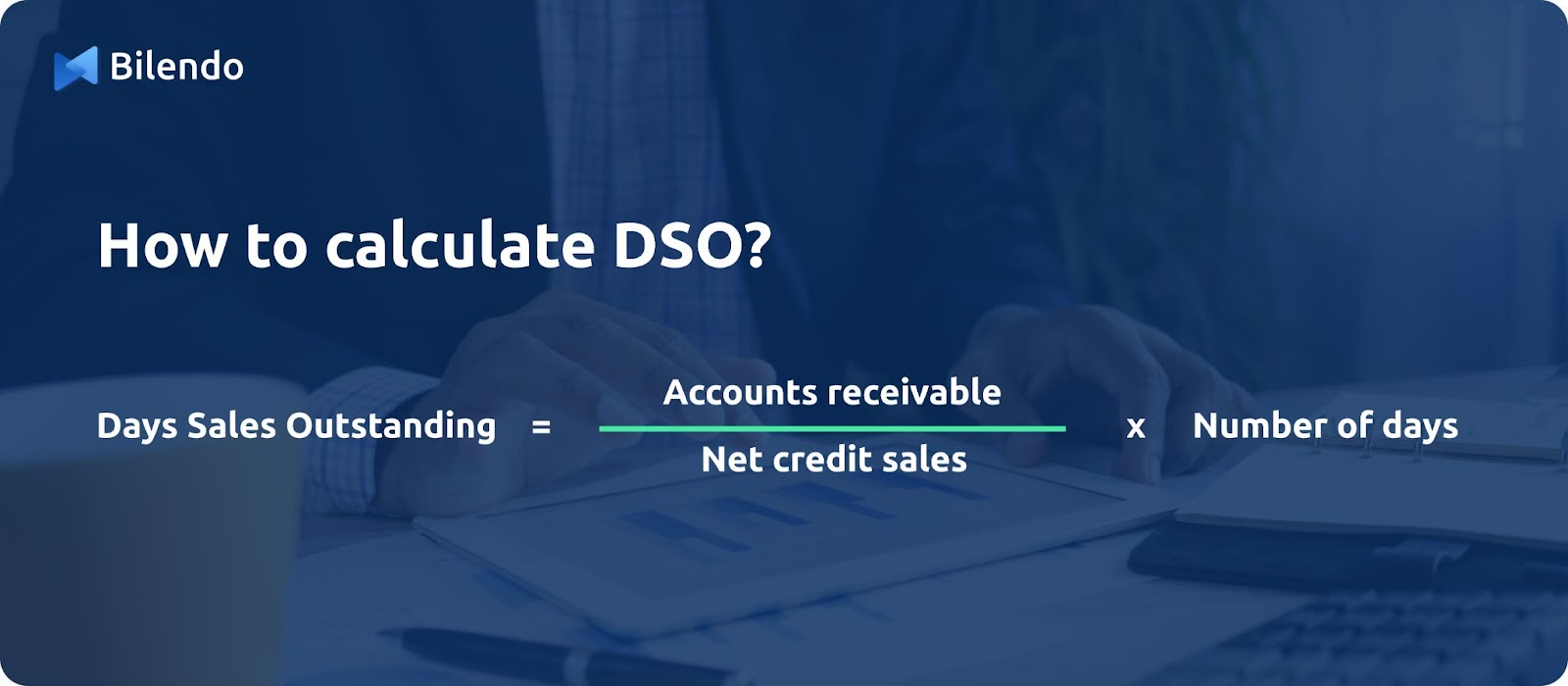As companies attempt for monetary success, one metric usually neglected is days gross sales excellent (DSO).
However what precisely is DSO, and why ought to CFOs take note of it?
This text explores how CFOs can enhance their firm’s monetary well being and handle its money conversion cycle.
You’ll delve into DSO, together with the way it’s calculated and what it means for working capital administration. You’ll additionally discover the affect of excessive and low DSO and examples of how optimizing DSO can positively affect an organization’s working money movement and total monetary efficiency.
What’s days gross sales excellent (DSO)?
Days gross sales excellent (DSO) is a monetary metric used to measure the typical variety of days a enterprise takes to gather cost from its clients after a sale. It’s additionally known as the typical assortment interval.
To calculate the DSO, divide the accounts receivables by the entire credit score gross sales and multiply the outcome by the variety of days.

Supply: Bilendo
- Accounts receivables are the amount of cash clients owe to an organization.
- Complete credit score gross sales is the entire quantity of gross sales made on credit score throughout a given interval (often a month or quarter).
- The variety of days is the variety of days in the identical interval.
Instance: If an organization had 100000$ in accounts receivable, 400000$ in credit score gross sales for the month, and the month had 30 days, the DSO worth can be: (100000$/400000$) x 30 = 7.5
By-product: On common, it takes the corporate 7.5 days to gather cost from its clients after a sale has been made.
With the assistance of the decided worth, conclusions might be drawn about varied components and provoke measures towards the related money issues. Moreover, DSO is likely one of the three main metrics measuring an organization’s money conversion cycle.
Why is DSO so vital?
DSO measures an organization’s monetary well being. When firms continually monitor their DSO, they acquire fascinating insights into their money movement and working capital administration.
Correct money movement and dealing capital administration are essential to an organization’s efficiency and development. When an organization’s collections course of is inefficient and funds usually are not acquired on time, the probability of a liquidity scarcity will increase.
Monitoring DSO over time means that you can determine tendencies and alter your gross sales and collections processes to enhance money movement. For instance, adjusting your credit score coverage reduces the chance of consumers defaulting on funds.
Furthermore, you should use DSO as a benchmarking instrument to match your efficiency along with your friends in the identical business. Evaluating your DSO to your rivals signifies how properly you handle your accounts receivables.
In case your DSO exceeds your friends, what you are promoting takes longer to gather funds. This might sign monetary difficulties or inefficiencies in your accounts receivable administration course of. Excessive DSO can result in money movement issues and negatively have an effect on your organization’s profitability as you must wait longer for the already generated income.
Alternatively, in case your DSO is decrease, your organization collects funds sooner, indicating an environment friendly and efficient accounts receivable administration course of. This helps improves money movement, improve profitability, and higher handle monetary dangers.
Typically, you need to maintain DSO as little as doable since a low DSO lets you use your full monetary potential. You additionally forestall monetary losses and keep away from insolvency. Low DSO is especially vital for firms with little accessible capital to maintain capital commitments low and capital effectivity excessive.
Why ought to firms monitor DSO?
DSO indicators efficient credit score and assortment insurance policies.
Excessive DSO values point out larger credit score threat. Because of longer assortment intervals, you possibly can have larger accounts receivable. This may trigger money movement issues if clients don’t pay on time or in case of dangerous debt write-offs.
Nonetheless, DSO isn’t the one helpful indicator of credit score threat. Exterior components (past an organization’s management) additionally contribute to the extent of credit score threat, such because the cost conduct of consumers, financial circumstances, and business tendencies.

Supply: Bilendo
Excessive vs. low DSO
Sometimes, a DSO of 45 days or much less is taken into account favorable. Nonetheless, an organization’s business closely influences a great DSO benchmark. Cost conduct, costs, and worth constructions differ in numerous industries.
For example, the retail business sometimes expects a decrease DSO. It is also price noting that companies that function on a money foundation, equivalent to supermarkets or fuel stations, sometimes haven’t got a DSO. Industries the place shopping for on credit score is frequent usually have the next DSO. Building, electronics, and equipment are the sectors with the best DSO, greater than 80 days.
Your corporation technique must also observe the DSO business common, particularly when increasing or transferring to a brand new nation. Checking the DSO common within the related business drastically helps for the reason that values from different sectors and areas shouldn’t be used as goal values for all sectors.
What ought to firms do after they have a excessive DSO?
An organization with a excessive DSO ought to first decide the components that contributed to it. Listed here are some doable components for a excessive DSO:
- Gross sales groups extending cost phrases to clients to spice up gross sales
- Clients being inspired to purchase merchandise on credit score, in order that they purchase extra services or products
- The effectivity of the gathering course of and the components that gradual it
- Credit score points for purchasers with detrimental credit score scores
Excessive DSO mandates fast motion. The money movement and the chance of dangerous debt improve with missed funds and sluggish course of enhancements.
Take these steps to reduce DSO and keep away from degrading your monetary efficiency.
-
- Modify cost circumstances. Not each buyer is similar, and their cost habits or skills could differ. For instance, setting stricter cost phrases upfront for purchasers who take extra time to pay their invoices is advisable. However don’t neglect to be form in your communication, regardless of their monetary standing.
- Optimize invoicing. By enhancing the invoicing course of, you possibly can cut back cost disputes and delays. Make certain your invoices are correct, full, and ship them out on time.
- Higher accounts receivable administration. Spend money on environment friendly cost monitoring to remind clients of unpaid invoices and outline clear assortment processes. Accounts receivable automation software program automates the dunning course of to observe funds extra exactly and effectively and speed up the gathering course of. In spite of everything, you’re setting claims for providers already delivered. You want the cash for working prices and new tasks or investments.
- Enhance credit score administration. Contemplate different measures to scale back DSO as a part of credit score threat administration. Persistently monitor every buyer’s creditworthiness to determine adjustments and alter the cost methodology. Moreover, good buyer communication helps you keep in shut contact with clients and learn about their requests, questions, and issues.
- Provide early cost incentives. Provide clients early cost incentives – the commonest provide is an early cost rebate.
- Scale back error charge. Guide work is error-prone, particularly in prolonged processes with many work steps; one thing can simply be neglected, delayed, wasted, or just forgotten. Discovering errors, fixing them, after which rebalancing them is pricey, time-consuming, and extremely annoying. Automating accounts receivable processes reduces the error charge and streamlines the movement of outgoing invoices and incoming funds.
What does a low DSO point out?
A low DSO signifies environment friendly and clean assortment processes. Reminders are despatched in good time, which implies clients pay on time. The accounts receivables, subsequently, don’t limit the corporate’s liquidity, and it may pursue new investments.
Why is optimizing DSO arduous?
Optimizing DSO might be tough for a lot of causes, most notably as a result of some firms don’t have any management over it. Under are the commonest causes firms wrestle to decrease their DSO:
- Buyer conduct: Companies can’t predict when their clients can pay. Whereas some clients could use their very own cost strategies, others are reluctant to pay for varied components, together with monetary difficulties.
- Buyer disputes: Cost delays could happen as a result of disputed invoices. Resolving a buyer’s disagreement over an bill can take time earlier than cost is acquired. Most firms resolve disputed invoices inefficiently, losing a lot of their sources.
optimize DSO
Work out a DSO technique to maintain the DSO as little as doable and maximize your liquidity. Set a goal DSO that aligns along with your present working capital and the sample it has proven previously. To set the precise goal DSO, take into account how far free money movement can drop. Additionally, verify your potential clients’ creditworthiness and collect detailed details about their cost conduct.
How do you profit from utilizing DSO accurately?
You derive an a variety of benefits from successfully managing DSO.
- Improved money movement: Reducing DSO accelerates collections, enhancing money movement and offering extra working capital.
- Diminished monetary threat: An organization with a excessive DSO threat elevated borrowing prices, liquidity issues, and an incapability to pay its collectors or suppliers. Profitable DSO administration mitigates these dangers and ensures the corporate has the sources to make well timed repayments.
- Profitability enhance: Companies that handle their DSO successfully improve profitability by decreasing the price of financing their receivables. This enables them to borrow much less to fund their operations when the DSO is decrease.
- Higher buyer relationships: Efficient DSO administration improves buyer interactions. Companies higher serve their clients and generate extra repeat enterprise by amassing funds sooner and extra effectively.
The connection between working capital and DSO
Working capital is the amount of cash an organization has accessible to fulfill its day-to-day bills and short-term monetary obligations. It’s the distinction between present property and present liabilities.
Money accounts receivable and inventories are present property as a result of they are often transformed into money inside a 12 months. Present liabilities equivalent to accounts payable, short-term loans, and accrued bills are due inside one 12 months.
Optimistic DSO signifies that half of the present property is financed with long-term capital. On the opposite detrimental DSO indicators that the present property aren’t ample to cowl the short-term liabilities. A part of the fastened property is subsequently financed within the brief time period. With a detrimental DSO, the corporate can shortly run into liquidity sooner or later.
Merely put, the upper the working capital, the safer the liquidity.
Moreover, DSO impacts money movement, which impacts the amount of cash accessible to repay short-term debt and day-to-day bills. An organization can enhance its working capital state of affairs and guarantee it has ample money to fulfill its obligations by correctly controlling DSO.
What does DSO imply in accounting and finance?
Companies that maintain tabs on their DSO can determine patterns and optimize their gross sales and collections processes to extend money movement and profitability. Use DSO as a benchmarking instrument to find out how properly you carry out in comparison with your rivals and what you should enhance your cost course of in the long run.
Accounting is not the paper jam it was once. See how AI is remodeling accounting and optimizing workflows.

